Jennie Goutet's Blog: A Lady in France, page 40
January 30, 2014
The Parisian Stone Called Meulière
Not surprisingly, the architecture in different regions of France varies quite a bit. In the Ile de France where I live – (The “Island of France” denotes the Parisian region and it encompasses quite a bit of the suburbs) – the principal architecture we see nowadays is square houses made of cement. Sure, they’re plastered and painted, but they sort of look like cookie cutter houses. You rarely see brick around here - and wood? Practically non-existent. But the old houses were built from meulière.

Meulière is pronounced mull (like mull it over) yair (like hair with a y). Mull-yair. It’s a reddish-brown stone that is very porous and is joined together with a lime plaster to create a wall. Meulière houses were built from 1880-1930, and were often embellished with iron railings, characterising the whole as Art Nouveau style. Let’s see some examples.
Here is a wall built from meulière stone.
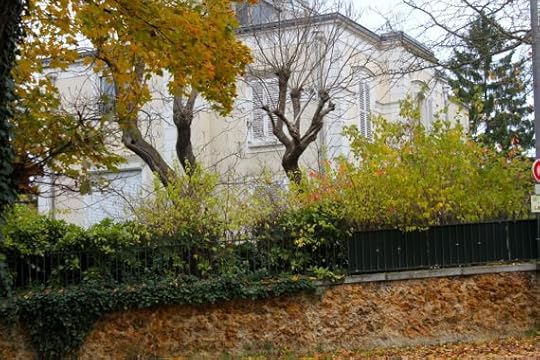
As you can see, meulière is most often reddish in colour. But it’s sometimes beige, or very dark beige – darkened with soot. It can be bits of stones that are plastered together like the wall you see up above, where the whole has a rather homogeneous look. This is actually called rocaillage (row-kai-ahge) – when you combine bits of stone with plaster and mix them together.
Or they can be whole stones with very rigid plaster borders like the wall you see just below.

Sometimes it’s just the façade of a house.
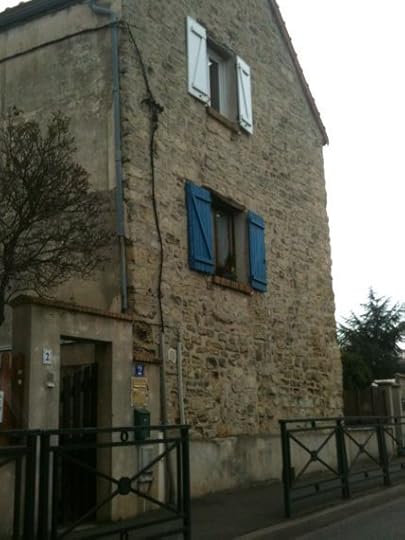
Sometimes it’s the entire house.

Our house would look exactly like this if it were a meulière.

We almost bought a meulière 4 years ago, but the timing/budget/location were not right.

I loved that house though. It had an extension for the master bedroom.

Sometimes we see urban influences crowding out these magnificent art nouveau houses.

And we also come across travesties, such as this one. A meulière house that was extended upwards in cement to create a singular eyesore.

But most of the time they look like this.

And this.

Totally Parisian. Totally magnificent.
The post The Parisian Stone Called Meulière appeared first on A Lady In France.
January 28, 2014
Cuisse de Dinde (Turkey Leg)
Cuisse de Dinde sounds so much better than Turkey Leg, doesn’t it? But that’s what this recipe is about. Cuisse actually means “thigh” and is pronounced ‘queese.’ And dinde is turkey, and is pronounced like dandy. Except the vowel is more the sound you make when you think something is just so-so. eh. Queese de Dehnde.
Alright, now that we’ve gotten that out of the way, on to the recipe. Do you see turkey leg sold outside of Thanksgiving? I don’t remember that from the States, but we have them a’plenty here. It’s a pretty common thing to cook in France.
I got my recipe from Marmiton and I basically just translated it for you. Nothing original in my recipe here. Except it’s probably unique outside of France, which is where an English translation probably comes in handy. Handy for your Dehndy.
Okay. I need a nap.
My cuisse was just over 3 pounds. 1.5 kilos. I got it from the butcher, and the friends who saw it joked about it coming from a horse or a wild boar. This sucker was big.
 I cut 2 large cloves of garlic in slivers.
I cut 2 large cloves of garlic in slivers.
 I pierced the meat all over and pushed the garlic in until it was almost completely covered.
I pierced the meat all over and pushed the garlic in until it was almost completely covered.
 I salted and peppered the meat, then smothered it with 4 heaping tablespoons of Dijon mustard, and sprinkled it generously with herbes de provence.
I salted and peppered the meat, then smothered it with 4 heaping tablespoons of Dijon mustard, and sprinkled it generously with herbes de provence.
 Then I made the marinade. I could have soaked it overnight, but I didn’t look for a recipe until the minute I needed it. So that was that. I combined 2 Tablespoons of soy sauce with 2 tablespoons of honey and a tablespoon of olive oil.
Then I made the marinade. I could have soaked it overnight, but I didn’t look for a recipe until the minute I needed it. So that was that. I combined 2 Tablespoons of soy sauce with 2 tablespoons of honey and a tablespoon of olive oil.
 Pour that over the meat, and into the oven it goes. You will have preheated to 180°C, of course.
Pour that over the meat, and into the oven it goes. You will have preheated to 180°C, of course.
 Every 15 minutes or so, take it out and ladle the sauce over the meat. Add more water if you need to. There should be enough sauce to pour over rice or noodles, or whatever you serve the turkey with.
Every 15 minutes or so, take it out and ladle the sauce over the meat. Add more water if you need to. There should be enough sauce to pour over rice or noodles, or whatever you serve the turkey with.
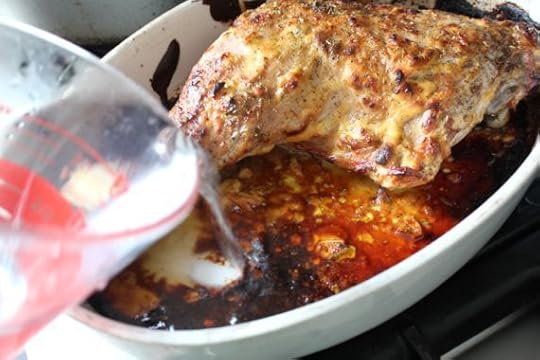 And then, after about an hour (an hour fifteen for mine) the turkey is done.
And then, after about an hour (an hour fifteen for mine) the turkey is done.
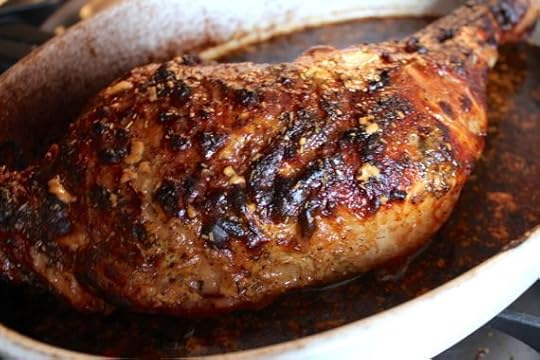 Cut in slices, pour the sauce over the top, and serve hot.
Cut in slices, pour the sauce over the top, and serve hot.
It is so amazingly good, you cannot go wrong with this recipe.
 Unless your guest is a vegetarian.
Unless your guest is a vegetarian.
* * * * *
I want to tell you about two people who wrote a book review of A Lady in France. The first is my friend Stacey of the blog Is There Any Mommy Out There. Stacey is such an exceptional writer it’s hard to pick just one thing to direct you to. I almost think I could close my eyes and pull a post out of a hat and it would be exceptional. I mean, let’s just take, for instance, this one. You see what I mean, don’t you? I read every single thing she writes and I love every one.
I identify with Stacey so much. Sure we have our religious differences, which we sort of celebrate – as it rather connects us as opposed to distances us. But she’s an adoptive mommy and a foster mommy (like the household I grew up in). And she loves to travel and she’s lived overseas. And she has a Bohemian spirit I completely relate to, not to mention her abhorrence of cold and crafts. We’re kindred spirits. And she wrote about my book here. I loved her review and I love her.
Tracie (who blogs at From Tracie) has also written a review. Tracie was faithful in reading my memoir when I was still publishing it a chapter at a time on my blog. And then she did me the honour of buying a copy and reading it again! How could I not ask such a sweet friend if she would talk about the book on her blog?
Tracie’s favorite color is yellow, which – I suppose – is insignificant in and of itself. But it’s not insignificant to me because yellow represents cheerfulness and hope. And Tracie is a survivor of child abuse. In fact, she is an advocate for other survivors and that is no small thing. Tracie’s survival story is here. To me, she is a hero, and I say that with a lump in my throat because no one should have to go through what she did.
She also had a miracle birth with her daughter who is close to Juliet’s age . It’s not that it was hard for her to get pregnant – you just have to read the story here to see for yourself. Tracie is an avid reader and we identify so much in our shared tastes in literature. I’m very honoured to have Tracie review my book, and the review is found right here.
* * * * *
I just want to mention one more thing. With marketing the book and my blog schedule (even if it is self-imposed) and my additional teaching hours, I don’t have time to respond to your comments right now. I’m sorry about that, but I read and treasure every one. 
Cuisse de Dinde (Turkey Leg)
Prep time
10 mins
Cook time
1 hour
Total time
1 hour 10 mins
Roasted turkey leg
From: Marmiton, translated by Jennie
Recipe type: Main
Cuisine: French
Serves: 6
Ingredients
Turkey leg
2 cloves garlic
Dijon mustard
herbes de provence
2T soy sauce
2T honey
1T olive oil
Instructions
Preheat the oven to 180°C or 350° F
Insert slivers of garlic into the meat at intervals.
Salt, pepper the meat and add mustard and herbs.
Mix the marinade and pour it over the turkey.
Add some water – about a cup, although not necessarily all at once.
Roast at least an hour and continue to ladle sauce over the meat.
Slice and serve hot.
3.2.1275
The post Cuisse de Dinde (Turkey Leg) appeared first on A Lady In France.
January 27, 2014
The Samaritan Woman
Samaritans were looked down upon in the time of Jesus, thus giving Jesus’ parable of the Good Samaritan much more impact with his listeners. That a Samaritan could be considered more righteous, more neighbourly, than a teacher of the law was just unthinkable.
The history between Samaria and Israel dates to about 1000 years before Christ. And let me preface my little history lesson here by saying that this story is pieced together from several messages heard over the years, the Scriptures 1 Kings 12-18, some of the minor prophets, such as Nehemiah and Ezra, as well as some fact-checking with the uber-reliable wikipedia.  In other words, there is room for error and I’m happy to be corrected.
In other words, there is room for error and I’m happy to be corrected.
Anyway, once King David’s son Solomon died in 930 BC, there was dispute over who should succeed him on the throne. The tribe of Judah (where Jerusalem was located) and the tribe of Benjamin accepted the ruthless Rehoboam, and the remaining ten tribes of Israel chose Jeroboam. Jeroboam wanted to fortify his strategic position, so he created a second temple of worship as an alternative to the temple of Jerusalem because he didn’t want his people leaving the area to worship in enemy territory. The only thing is, he didn’t build a temple to God, he built a temple with two golden calves and said, “Here are your gods, Oh Israel.” (1 Kings 12:27)
The fact that he turned to foreign gods was one thing. But Israel was also conquered by the Assyrians twice over the span of two centuries and the Israeli people mixed together in marriage and in worshipping false gods. The pure race was compromised. Fast forward to Jesus’ time, the Israelites (what was then the people of the tribe of Judah) detested the Samaritans for the fact that they were impure in both blood and worship. They were no better than pagans. In fact, if you can find a map of Palestine in the time of Jesus, you’ll see that Israel is divided, with Galilee on top and Jerusalem on bottom, and Samaria right smack in the middle.
The Israelites would travel regularly from the North (Nazareth, Galilee) to the South (Jerusalem) in the time of holy days and feasts so they could participate in the worship at the temple of Jerusalem. Except, instead of taking the most logical route and cutting straight through Samaria, they would add miles and miles to their journey by going around Samaria, just so they wouldn’t have to mingle with its people. That’s how much they hated the Samaritans.
And now we’ve properly set our story for today. This is in John 4:
Now Jesus learned that the Pharisees had heard that he was gaining and baptizing more disciples than John— although in fact it was not Jesus who baptized, but his disciples. So he left Judea and went back once more to Galilee.
Now he had to go through Samaria. So he came to a town in Samaria called Sychar, near the plot of ground Jacob had given to his son Joseph. Jacob’s well was there, and Jesus, tired as he was from the journey, sat down by the well. It was about noon.
When a Samaritan woman came to draw water, Jesus said to her, “Will you give me a drink?” (His disciples had gone into the town to buy food.)
The Samaritan woman said to him, “You are a Jew and I am a Samaritan woman. How can you ask me for a drink?” (For Jews do not associate with Samaritans.)
Jerusalem was located in Judea, and Jesus left there to go back North to Galilee. After reading the history, you might find it strange (as I’m sure his disciples did at the time) that he had to go through Samaria. Already, Jesus was breaking convention by doing this. But then he came to the town of Sychar. The Hebrew meaning of Sychar is “liar” and “drunkard.” This town was not named “Mount Pleasant” or “Gladstone.” And there is good reason to suspect that the people comprising this town fit the bill. Names don’t come out of nowhere, and Jesus chose to stop off in a place that was known for how low its inhabitants had sunk in morals.
And here is is noon – the hottest part of the day. In those times, gathering water was a social thing. Women would go to the well very early in the morning when it was still cool, and then again at the close of day when the afternoon sun had passed. They would fill their buckets and do their washing. And they would talk and connect with other women as they went about these mundane tasks. So . . . why was this woman coming to get water all alone? We’ll see about that in a minute.
When Jesus asks her for a drink, she is stunned. How is it that you are talking to me? I’m a woman! In those days, women had no rights and no status. Men didn’t just talk to women like that, especially not Israeli men. And I’m a Samaritan!
(starting again in vs 10) Jesus answered her, “If you knew the gift of God and who it is that asks you for a drink, you would have asked him and he would have given you living water.”
“Sir,” the woman said, “you have nothing to draw with and the well is deep. Where can you get this living water? Are you greater than our father Jacob, who gave us the well and drank from it himself, as did also his sons and his livestock?”
Jesus answered, “Everyone who drinks this water will be thirsty again, but whoever drinks the water I give them will never thirst. Indeed, the water I give them will become in them a spring of water welling up to eternal life.”
The woman said to him, “Sir, give me this water so that I won’t get thirsty and have to keep coming here to draw water.”
He told her, “Go, call your husband and come back.”
To me, this women shows some spunk. First of all, she challenges him for speaking to her. And now she’s making sure to drive the point home that Samaritans have a blood inheritance too. She’s reminding him that she belongs to Jacob and Joseph just as well as he does.
But Jesus surprises her. He tells her about the water she knows nothing about – one that goes beyond the well that was dug by Jacob himself. This water will spring to eternal life. When she wants to know more, he tells her to get her husband and come back.
(in vs 17) “I have no husband,” she replied.
Jesus said to her, “You are right when you say you have no husband. The fact is, you have had five husbands, and the man you now have is not your husband. What you have just said is quite true.”
“Sir,” the woman said, “I can see that you are a prophet. Our ancestors worshiped on this mountain, but you Jews claim that the place where we must worship is in Jerusalem.”
“Woman,” Jesus replied, “believe me, a time is coming when you will worship the Father neither on this mountain nor in Jerusalem. You Samaritans worship what you do not know; we worship what we do know, for salvation is from the Jews. Yet a time is coming and has now come when the true worshipers will worship the Father in the Spirit and in truth, for they are the kind of worshipers the Father seeks. God is spirit, and his worshipers must worship in the Spirit and in truth.”
Now we start to get some idea of why she’s alone at the well. Did you pick up on that? Five husbands and not even married to her current lover. Even in today’s ultra-liberal society, a woman will not be well-looked upon to have been married five times. And now we see the likely reason she is alone. None of the other women in the town will have anything to do with her.
When she confesses to not having a husband, Jesus gets right to the heart of the matter and tells her exactly what she has done with her life. He doesn’t judge her, but he reminds her of where she’s at. And you can see that it makes her uncomfortable. She diverts the topic and starts talking about “religious stuff.” I can see that you are a prophet. She draws the focus away from herself.
And here’s where I see this woman’s spunk again. “You Jews claim that . . . ” She refuses to accept that her people are inferior to the Jews. She brings up the point of dispute about where it’s acceptable to worship, whether it’s in Samaria or in Jerusalem.
And Jesus confounds her again. You don’t worship what you know. You need the Jews because salvation comes from the Jews. But soon – and even as we speak – it won’t matter where you will worship. It only matters where your heart is. God is spirit, and his worshippers must connect with him in spirit, and in truth.
And then – the most beautiful part (picking up again in vs 25)
The woman said, “I know that Messiah” (called Christ) “is coming. When he comes, he will explain everything to us.”
Then Jesus declared, “I, the one speaking to you—I am he.”
I could tell you about how the disciples came back and were shocked to see him talking to a Samaritan woman, and breaking all convention to do so. I could tell you about how she braved the scorn of the town to let everyone know that Jesus was the Messiah by saying, “He told me everything I ever did!” I could tell you about how the entire town believed Jesus because of her testimony. But I will only tell you about this:
Jesus hadn’t officially revealed to anyone he was the Messiah, not even to his own disciples. But in the country of Samaria, considered inferior to the Jews; in the town of Sychar, a place where undesirables congregated – the liars and the drunkards; and amid all the potentially upstanding men of the town, Jesus chose a woman. He chose a sinful woman, who was rejected by her peers, in a town, which was rejected by her country, and in a country rejected by its brethren. It was to this woman that Jesus claimed for the very first time that he was the promised Saviour.
“I, the one speaking to you – I am he.”
* * * * *
Image credit: 123rfkasami / 123RF Banque d’images
The post The Samaritan Woman appeared first on A Lady In France.
January 24, 2014
Getting Organized
Walking Hunter is a very messy task because he’s a hunting dog and needs to run in the wild. I took advantage of the sale season to buy new rubber boots that could take me where I needed to go.
I got the ones with pink soles and jewelled medallions on top so I would look cute as I was traipsing along in nature.
 Makes such a difference that the boots are cute, doesn’t it?
Makes such a difference that the boots are cute, doesn’t it?
In my new desire to be “equipped in season and out” I was taken (in?) by these designer rubber gloves for doing the dishes. There were various patterns at the store, each more elegant than the last. And I thought I might turn into June Cleaver if I bought a pair.
What better way to get organised than sliding on a new personality like you do a rubber glove?
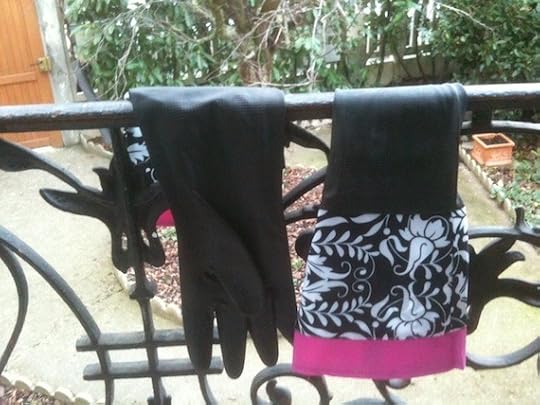
I haven’t used them though. They’re too pretty and I’m afraid of ruining them. Plus, I always forget they’re there. (Or I’ll see them, but I’m too lazy to put them on).
But I don’t weary of trying. In an effort to fight the post-holiday battle of the bulge, I read up on the “clean eating” plan that a friend recommended. We’re pretty good in this area for the meals in terms of everything homemade. It’s the breakfasts and snacks that do us in. Those are not healthy at all. And I, personally, eat way too much sugar. It all seemed pretty easy to do, so I got out my shopping bags and went out.
Whole-wheat bread from the boulangerie for the non-coeliacs in the house.

Brown rice pasta and gluten-free oatmeal for the whole family.
 A large tub (eco-friendly) of fresh fromage blanc to be eaten with agave syrup.
A large tub (eco-friendly) of fresh fromage blanc to be eaten with agave syrup.

And a visit to the butcher, whose meat is more reliable and fresh than the packaged stuff.

Erm. Fresh being the key word here. Shoulda asked them to hack off the . . .
I’m trying. I’m trying to get organised. But you know, organisation is not my strength. At. All.
I’m a little better at saying thank you. So let me tell you about the two people who wrote reviews of A Lady in France this week: Dr. Jessica Smock wrote a review on Wednesday, and Kerstin Auer wrote one today.
Jessica is a new friend who writes at School of Smock. I got to know her from reading The Her Stories Project, which is an anthology of women writers she co-edited and wrote for. In fact, I’ll be doing a review of that book in two weeks. You can find the Amazon link for her book on her blog.
I felt very humbled and grateful when I read Jessica’s review of my book. I loved her take on memoirs as a genre, particularly from her point of view as an English teacher. And I loved reading that the travel part of my book was still interesting to someone who has not traveled, and the faith part was not distracting to someone who has no interest in God. It was very encouraging.
My favourite post of Jessica’s is on “grit.” Not grits, like a southern thing. But true grit. And this girl has it. She found a way to attend boarding school as a high school student and you will not believe how she did it. Read about it here. Jessica also overcame her reticence about speaking of her short bout with anorexia because she thought it would help people. And she was right – it is helping people. You can read about that here.
* * *
Kerstin blogs at Auer Life and she’s German. This might not mean a lot to you, but I feel like she’s part of the family since my mother’s maiden name is German, my aunt was stationed for years in Kaiserslautern (where I went to visit her during my semester abroad in Avignon), and my brother-in-law is German as well. With all these connections, Kerstin and I are quite possibly related!
Kerstin has always been very supportive of my writing, and even graciously gave me an author’s quote for my back cover! This means a lot to me as a fledgling author. Kerstin is similar to Jessica in that she was skeptical of how she would handle the faith aspect once she caught on to that nuance, but did not find it a deterrent. She’s different to Jessica in that she has traveled. In fact she writes travel guides. In German! (Here’s a shout-out to my brother-in-law who could actually understand them).
The first post I remember reading of hers is this one. Go read it. It’s short, and it made me giggle. And I can relate. A more recent one is her 5 Rules for Success post. Since Kerstin earns her living as an author and a freelancer, she has something to say about that. You can read that here.
Thank you to both Kerstin and Jessica from the bottom of my heart for your kind words and your incredible support.
The post Getting Organized appeared first on A Lady In France.
January 23, 2014
Palais de la Découverte
The Palais de la Découverte (pronounced pah-lay de la day-coo-vairte) is located on Franklin Roosevelt Avenue, just off the Champs Elysées. It’s a discovery museum for children, housed in part of the Grand Palais, which was built for the 1900 World’s Fair (Exposition Universelle).
I had to do a little research, actually, as I knew the Eiffel Tower had also been built around the same time, and was also created for a World Fair. However, the Eiffel Tower was built about a decade before the Grand Palais, and it was used as the entrance to the 1889 World Fair, held to mark the 100-year anniversary of the French Revolution. Though it was nothing new by the turn of the 20th century, the Eiffel Tower was still featured in the 1900 World Fair, along with the newly built Grand and Petit Palais, and the Pont Alexandre III. You can read more about the Grand Palais here, and the Eiffel Tower here.
Now, we visited the Palais de la Découverte before Christmas, but I haven’t had time to write about it until now. I must say that this turns out to be perfect timing, because Alison of Writing, Wishing will be coming to visit ME with her family!
Oh yes, I suppose Paris might possibly have something to do with her visit (yawn), but really you see what an influential blogger I am, right? People come from the Far East to meet me!
So the pressure is on. I need to find some kid-friendly, tourist-worthy destinations, and STAT. So here it goes.
Here is the magnificent Grand Palais from across the Seine. We’re on our way!

It is such an incredible feeling to take a timeout from routine and do something as a family. The kids need this. We need this.

Look! It’s Aslan (says William)! He imitates the cherub.

And in we go.

Wow.

This is a science museum? The Grand Palais was meant to be torn down after the World Fair, along with the other related edifices, such as the Eiffel Tower. But just look at the details that went into building this thing.

the iron stair railings
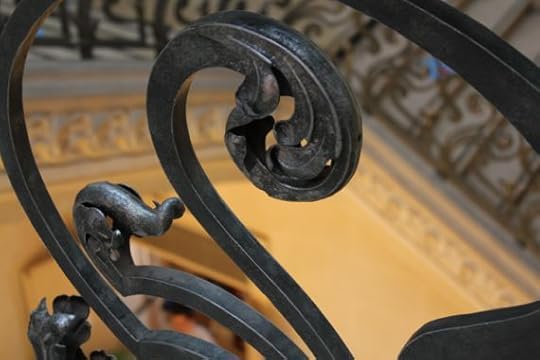
the sculptures and moulding on the ceilings and columns

looking up

looking down



We don’t spend that much time and effort on things that are meant to last for decades. It’s such a shame architectural beauty is so rarely considered essential these days.
 This place is kid heaven.
This place is kid heaven.
There are the beasts

the human body

light and telescopes

motion and weights.

There is stuff to listen to

stuff to watch

and plenty of places to sit down

(whether or not a movie is in session).
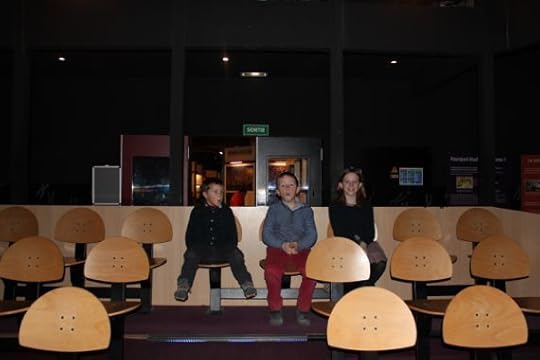
There are places where daddy and mommy’s help is indispensable

and places where daddy and mommy are just as clueless as the kids are.

This is the Pi room. And the classroom where smart people get to go. #munchesonpeanuts

And there is really so much more – planets, power, electricity – you name it! If it’s related to science, it’s there.
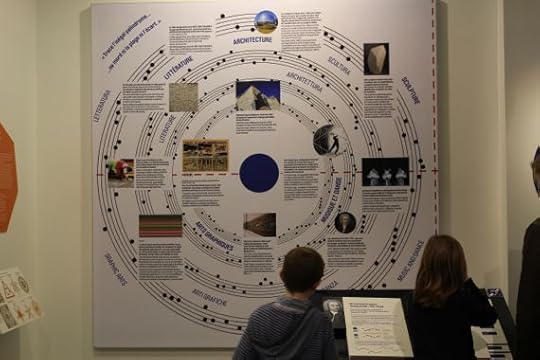
We left before meltdowns from walking and hunger could occur, and walked into early winter nightfall. See how the lights bring these paintings to life on the side of the building?

Alison, I just know the discovery museum in the Grand Palais is one place your kids won’t want to miss.  Details in English, including hours and ticket price, are found here.
Details in English, including hours and ticket price, are found here.

Speaking of Alison, she and Greta host weekly photography linkups called “Through the Lens,” and last week’s theme was motion. These pictures from our day at the museum would have been perfect to link up, don’t you think?

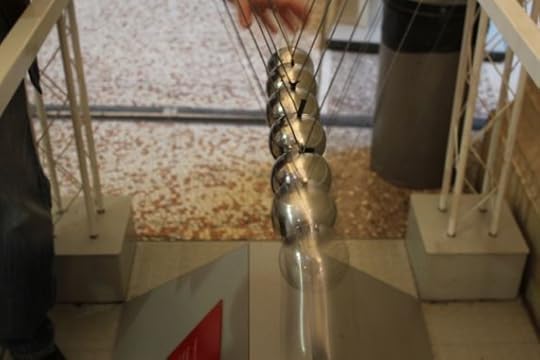
This week, the theme is the colour white -

our radiator at home, caught at just the right moment of the day for the sunlight to reflect off the white rows. Which of the two, do you think captures the white better?

If you’re a fan of photography, don’t forget to link up here.
The post Palais de la Découverte appeared first on A Lady In France.
January 21, 2014
How to Cook With Herbs
I was supposed to have a really great recipe for you today, combining beef and prunes. But it wasn’t good. I mean, it was edible, but nothing I would post here. So I decided to do a tutorial I’ve been meaning to do for a long time on how to cook with herbs.
You all know I’m an amateur chef, but I have been cooking for over twenty years, and that includes inspiration from recipes, things I’ve tried myself through imitation or imagination, and things I’ve learned from living in different countries. There are many recipes I make from habit, and I have my standby herbs that I use for different foods. This is what I am sharing with you.
BASIL. This herb is probably the most common. I would grow it, except that I am too lazy to repot it and bring it indoors each year. We can also buy basil frozen here, which is just as good. Basil tastes a little sweet (to me) and therefore I use it in soups, as well as in flavouring rice, pasta sauce, and quinoa. It seems to go better with starches, and I rarely use it on meat.
THYME. This is my go-to herb for meat. I use it on lamb. When I roast leg of lamb, I cut holes everyone in the meat and stick slivers of garlic in the holes. Then I salt and pepper the entire thing, and sprinkle with thyme. Like I did here. I use thyme on chicken with Dijon mustard, and it also marries well with lemon and garlic. Thyme grows really well and is a perennial plant, so no digging it up for the winter.

OREGANO. I like to put oregano on beef. I’ll heat oil in a pan until it’s sizzling hot. I put the steaks on the pan, then salt, pepper and sprinkle oregano. And I turn the steaks over just once to sear the outsides but keep the insides rare. We’re a big fan of Dijon mustard here so we often dip the steak in the mustard as we eat it. I also use oregano to doctor up regular spaghetti (tomato-basil) sauce to use for pizza. To me, pizza should have oregano. But my Italian friend – from Italy – says only basil on pizza. That’s for you to decide.
BAY LEAVES. These go in soups and stews. When you buy them dried, you can’t imagine that they will make any difference in the flavour, but they really do. If you take a fresh bay leaf right off the tree and rub it between your fingers, you’ll see how fragrant it is.

If I’m going to make a plain chicken soup or vegetable soup, I will always put basil and bay leaves. Except . . . the traditional French purée soup seems to be okay without any herb whatsoever. One last word about bay leaves. Don’t chop them up because you they’re too sharp and tough to chew. You have to keep them whole and remove them at the end of cooking.
 I really need to trim this bay laurel tree.
I really need to trim this bay laurel tree.
BOUQUET GARNI. This is a bundle that is tied together for pot au feu or other stews and it comprises thyme, bay leaves and parsley. I don’t usually tie it together because I don’t have the right string. I just fish the stems and leaves out when I’m done cooking the stew.

PARSLEY. I have to be honest. I don’t use this often. I forget to buy fresh, and the dried seems to be no good at all because there’s no flavour or sent left. This is another herb I would have to bring in for the winter if I grew it. When I do use it, however, it’s for potatoes or salad dressing.
ROSEMARY. This is a gorgeous herb. It grows quite big into a bush that can come up to your waist. It’s got a distinct flavour, however, and I don’t use it often because the kids would not likely eat it. When I do cook with it, I put it on potatoes or chicken.

TARRAGON. This has a sweet sort of anise flavour. You can’t imagine using it for meat, simply from its smell. But I use it for my chicken recipe that has a sauce made of tarragon, Dijon mustard and sour cream. It’s easy, it’s delicious, and it’s unusual.

CHIVES. I buy these frozen, although I will use dried too since I rarely grow them. I use chives on fish, and in vinaigrette salad dressing. For a sauce to go over white fish, I melt sour cream in the microwave for a minute, along with cut chives and salt. It’s a quick sauce to prepare that even children will eat. I mean, who doesn’t love sour cream and chives?
SAGE. Sage also has a distinct flavour and blends well with garlic, lemon and parmesan. I don’t often use it, but when I do, it’s on chicken or turkey breast, or lamb chops.

I didn’t really pick the best season to catch all these herbs in their glory, did I? But sage blooms purple in the springtime, and boy is it magnificent.
HERBES DE PROVENCE. This is a mix of thyme, oregano, rosemary – and the less familiar marjoram and savoury. I also find this to be distinctive in flavour that doesn’t go with everything. I only use it when I roast an entire chicken. And sometimes I’ll use it on beef.
So, in a nutshell, on:
Beef, I prefer to use oregano, and sometimes Herbes de Provence.
Chicken or Turkey, I use rosemary or sage on the poultry breast, and thyme or Herbes de Provence on the entire bird.
Lamb, I use thyme or sage.
Pork, I use just salt and pepper. Nothing else, unless I’m making a vanilla-honey sauce to go with it.
And in:
Rice – I use basil.
Quinoa – basil as well.
Tomato sauce – basil for spaghetti & basil and oregano for pizza.
Ratatouille – basil.
Soups – for many of them I put basil and bay leaves.
Meat Stews – for many of them I put thyme and bay leaves.
Tell me what kind of herbs you use in cooking? What are your go-to herbs? I would love to hear your tips in the comments.
* * * * * *
I want to tell you about Angela Amman’s review of my memoir A Lady in France. Angela is an author, and I read and loved her book of short stories, called “Nothing Goes Away.” I’ve also downloaded, but have not yet read, the anthology for which she is editor and contributor, called “Precipice.” I know a few of the other authors in the book and I know it’s going to be great. You can find the links to these books on her website.
Angela also writes fiction on her blog, but I identify it mostly with her book reviews. You’d think book reviews would be boring to read after the first one or two, right? Especially if you know you’ll never read the book (because you hate to read or because you live really far away and avoid buying English books – ahem). But it’s not boring at all! She doesn’t just summarise the book, she relates them back to her life in a way that brings it all together.
In the case of my review, she told of her time as a tourist in Europe, which happened years ago. But many of her posts bring the books she reads to life by making sense of them through what Angela is living now. This is a perfect example of that. Her reviews are always good, always interesting in and of themselves. There is literary maturity to how she analyses and summarises the books she reads. You can see that she has a long habit of devouring one book after another of all genres, then reflecting on each one. I usually want to read every book she reviews.
Her review of my book was just such a joy to read. Thank you Angela!
The post How to Cook With Herbs appeared first on A Lady In France.
January 20, 2014
When You Can’t See the Meadow
My dog is sick. He caught a tic-related illness called la piroplasmose in French, and it attacks the red and white blood cells, the liver, and the kidneys. It’s pretty serious, but we brought him in as soon as he started showing symptoms. He had been vaccinated against it, and I put the tic repellant faithfully every month. And yet he caught it from the one tic that managed to latch on. Fortunately, the fact that he had been vaccinated slowed down the symptoms so it didn’t reach his kidneys before we were able to get him some help.

He’s too tired to even chew on the shoes in the open cupboard behind him.
My husband is away. He left for Minnesota on Wednesday, came back Saturday morning for the weekend, and he left again this morning for another week in Hollywood. I always feel frightened when he’s away. I always wonder what it would be like to lose him in a fiery plane crash. Or I imagine that the plane lands safely, but the crazy taxi ride from the airport will do him in – although this fear is less than the plane ride. Losing my husband is a real fear of mine, and every time he goes away, it is a reminder of how fragile life is.
And then I’ll get the text, “Just landed” and I know that all is well in the world again. I know that – if he’s away – I have a few more days before he has to take the plane again. Or if he has just landed in Paris, I know he will be home within the hour. The person who is my rock will be here to hold the fort, to share the burden, to conquer life together in love and friendship.
Friday was crazy. I spent the whole day in La Defense, barely had enough time to eat and put away the perishables before picking my kids up at school. We then spent an hour waiting at the orthodontist because they forgot about us (and apologised profusely, to their credit). We barely had enough time to get home and ready the house before the people came for the weekly Bible discussion.
I didn’t have to host it, of course. Matthieu wasn’t here and it was a hectic day. But I thought it would do me some good to have the company, and the kids would do better to play with other kids than to sit in front of their Nintendo all evening. So I agreed to host.
But as we were madly getting ready, I did think to myself – what have I gotten into? I should have canceled! I don’t have time for this.
And then the friends arrived, we sat, and Rado opened the Bible to John 10.
The Good Shepherd and His Sheep
“Very truly I tell you Pharisees, anyone who does not enter the sheep pen by the gate, but climbs in by some other way, is a thief and a robber. The one who enters by the gate is the shepherd of the sheep. The gatekeeper opens the gate for him, and the sheep listen to his voice. He calls his own sheep by name and leads them out. When he has brought out all his own, he goes on ahead of them, and his sheep follow him because they know his voice. But they will never follow a stranger; in fact, they will run away from him because they do not recognize a stranger’s voice.” Jesus used this figure of speech, but the Pharisees did not understand what he was telling them.
Therefore Jesus said again, “Very truly I tell you, I am the gate for the sheep. All who have come before me are thieves and robbers, but the sheep have not listened to them. I am the gate; whoever enters through me will be saved. They will come in and go out, and find pasture. The thief comes only to steal and kill and destroy; I have come that they may have life, and have it to the full.
As we read this, I was reminded of a message I once heard where the minister explained that shepherds would lead their flock into an alcove for the night. The natural surroundings would provide a sort of fence on all sides, except for the opening. And that’s where the shepherd would lie down for the night. He was the gate and the attackers would have to get past him if they wanted to access the sheep.
Shepherds were (are?) fearless. King David attacked lions and bears if any of them carried off one of his sheep, which is why he was not afraid to go up against Goliath. (1 Samuel 17) I’m sure it was also why he was chosen to be king, and why he was a man after God’s own heart.
As we read about Jesus being our shepherd, Francine (Rado’s wife) remembered Psalm 23 – the first Scripture I ever learned as a child.
The Lord is my shepherd, I lack nothing.
He makes me lie down in green pastures,
he leads me beside quiet waters,
he refreshes my soul.
He guides me along the right paths
for his name’s sake.
Even though I walk
through the darkest valley,
I will fear no evil,
for you are with me;
your rod and your staff,
they comfort me.
I usually think of the valley of the shadow of death (as it’s worded in a different translation) as grief. I know that valley well. And with the benefit of years of healing and retrospect, I can attest that Jesus has been there guiding me through it. I may not see the green pastures ahead. He does. I may be thirsty, stumbling on dry sand, unable to find the cool spring ahead. He can.
But what struck me this time around is the fact that I am walking through a different valley right now. And it’s not due to grief – it’s due to feeling inadequate.
I had tension with a very good friend and it’s not resolved yet. I’ve tried to make a budget and there are already unexpected expenses to derail it. We have trouble breaking even each month and it doesn’t make me feel better that all of the other French people are in the same boat. I made some headway in health and weight-loss during our 40-day fast (although that was not the goal), but the holidays did me in, and all of the sugar I ate went right to my waist. I can’t fathom finding any eating plan that I can do long-term because I’ve tried everything already.
Our house . . . oh, our house – the blessing and the curse that is our house. There are always things going wrong and I have trouble remembering this house was an answered prayer when I see the sockets coming out, the hedges that need trimming, the many projects that we will never have time for. This is my valley right now.
But Jesus is walking with me and he can see where we’re heading. He can see the frailties in my character that seem so monumental to me and he knows how to carry me through. He can see the sorrow, the guilt, the feelings of overwhelm, but he’s not worried or in despair. He knows right where he’s leading me.
By Saturday morning, Hunter’s symptoms had become pronounced. I had to wake him up to go outside and do his business and he refused food. I wasn’t sure how we were going to manage this because I had to start my English classes within the hour. But then I got the text earlier than expected: “Just landed!” and I was able to call and get a vet appointment last minute that Matthieu was able to take Hunter to as soon as he got home.
And I later had my chance to express a lot of how I was feeling regarding the projects in the house. I made the connection that – in addition to the overwhelming fear I have of losing my best friend in the world to a fiery plane crash (still talking about Matthieu here, not my other friend) – I have no idea how I would carry on without him in this money pit of a house that has more projects than I know how to handle.
But on Sunday, we were able to tackle one of the projects that contributed to the valley – our bedroom. It’s always had too much junk and too much furniture. Far from being a haven of peace, it’s a dumping ground. So we removed one item of furniture and arranged the rest so it looks more like a green meadow than a junkyard.
And then the one thing I had been fearing – Juliet getting locked in her room because her door handle had fallen off months ago – finally happened when Matthieu was right there to get her out and fix the door. Sure, Matthieu spent much of Saturday and Sunday afternoon creating the perfect neurolizer for his Men in Black costume for his upcoming company trip (where costumes are mandatory for one of the parties)

oh honey, this is exactly how I hoped we’d be spending the weekend
- but I could still see the springs of water in the midst of the frustration, and we had a great weekend despite everything. I feel recharged and ready for Matthieu’s absence again this week. We even managed to have our Sunday night family devotional in our new attempt at being better shepherds to our own kids. It was all just what I needed.
Jesus is leading me towards the meadow. It may not always be at the pace I’d like. Sometimes the visions of barren wasteland fill my sight for far longer than I would like. But he’s protecting me, and leading me to where it’s green and fresh, even when I can’t see how to get there.

And he’s leading you too, if you’ll let him.
The post When You Can’t See the Meadow appeared first on A Lady In France.
January 17, 2014
Sunsets+Shopping=Serenity. Sorta.
I did manage to clean my floors yesterday after all. After talking with my tribe, they encouraged me to just pick one thing to do (to get out of my mental funk) and I realised having muddy floors bothered me more than anything else. So I mopped them. And I felt so much better.
And then, since my long-suffering dog had also been neglected for his morning run due to the heavy rain, I brought the kids out with me to give him a late afternoon walk.
Off he went into the sunset.

Off he went into the fields.

And then he found his friend Sandee who is a shepherding dog. She tries to shepherd him, but she has a hard time because he’s a hunting dog and he can run faster. They both have lots of fun and sleep the better for it.
So I managed to get my act together despite being in a funk.
And then today I went into La Défense to get some shopping done because I wanted to go to certain clothing stores while the sales are still going on. Of course I had to get my weekly groceries as well, which is much less romantic, but that did not deter me.
I met my friend Amina at Starbucks and we got caught up on our lives. They’ve installed this new light photography on the screens in the mall, which is really pretty.

And we hit the stores. Gap for Gabriel because he is thicker around the waist than most French kids and the pants fit him with room to spare. And my favourite store for girls (and women) – Cyrillus.

I could splurge since it was the sale season. See what I got for Juliet?
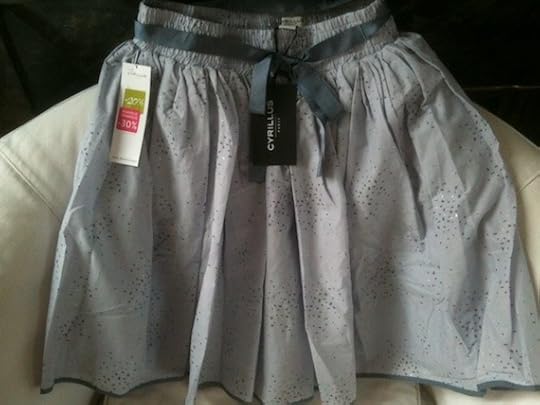
So although this has not magically brought my husband home or prepared my English lessons for tomorrow or made the dinner for tonight, it did give me courage to face all of that because I got out of my home and spent time with a friend.
Speaking of friends, Greta of G*Funkified has written a gorgeous review of A Lady in France here. Greta is . . . simple elegance. That’s what I think of when I think of her. I was first introduced to her through her story on grief. I’m drawn to grief because of my own experiences, which makes me a sensitive listener (a plus), but perhaps a rather morbid person. The jury is out.
Greta wrote about losing her husband to a drunk driving accident when she was newly pregnant with her second baby – before they had even told anyone she was pregnant. She wrote about that here. I sobbed. She also wrote about being a phoenix – getting remarried and having two more babies in addition to her first two – here! And her husband is an amazing father to all four of his children.
But Greta is more than that. She runs a gluten-free household for her daughter who has coeliac disease. She hosts photography improvement posts, runs every marathon she can, including Disney (see aforementioned photography post), and she lives in a really rural setting, which she insists is not romantic, but I think it really is.
A huge thanks to my friend Greta, who was willing to read my book and share about it. 
So that was my day – a little sunset, a little shopping, a little craziness since there was a lot of running around – running around which culminated in an orthodontist appointment that took hours. But all in all it was pretty serene.
Sorta.
The post Sunsets+Shopping=Serenity. Sorta. appeared first on A Lady In France.
January 16, 2014
Epiphany
I just need to plunge right in, don’t I? It’s Thursday’s post on France and I promised to write about the Epiphany celebration where all of France (Europe? The Eastern Christian Churches?) eats the galette des rois. With alcoholic bubbling cider.
But I’m having trouble plunging right in because I’m distracted. I’m forlorn because my husband is in Minnesota (he just discovered the walkways that connect the buildings out of the blinding snow there and he’s really pumped about it). I’m also indecisive because I didn’t have time to walk my dog this morning and he keeps looking at me pointedly, but it’s really wet out. And I’m overwhelmed because my floors are covered in muddy bootprints and paw prints and I don’t know if it’s worth it to mop just yet or will they get muddy again? So you see why I’m distracted?
But a writer must write, even if it’s only because she promised to have a Thursday post on France or because she promised to let you know about all the book reviews and kind words that are being sprinkled over the blogosphere. In fact, let me tell you about one such review.
I don’t know how I found Andrea from About 100%, but one day she commented on my post. And when I went to check out her blog, I was in stitches at the unassuming way in which she writes. It takes real skill to keep your face deadpan when you’re telling a story, adding humour to the scenario by your completely impassive expression. It takes even more skill to do that in writing when you can’t even see a person’s face, and yet you’re swept up in the humour of (what you know is ) their blank stare and blinking eyelashes that accompany the words.
Andrea’s humour comes out in her crafting expeditions, her adventures in the kitchen, and the way she rocks at decorating. Seriously, even compiling this list (and it was really hard to select just three) had me giggling from all the memories of reading these posts for the first time.
And Andrea has been kind enough to review my book for me. She is giving away a copy of A Lady in France, and her review (complete with her own French story) is found here. I just know you will love Andrea.
Back to the Epiphany. The Christian take on things is that the wise men came to visit the baby Jesus twelve days after his birth, which falls on January 6th. Catholic tradition states that this was God’s manifestation to the gentiles, and it celebrates the first feast that is linked with Christianity.
As I mentioned in Tuesday’s post, a porcelain figure, called a fève, is hidden in the galette des rois. To avoid the temptation of searching for it as the pieces are cut, tradition has it that the youngest member of the family (or guests) crawls under the table, and as each slice is cut, he calls out the name of somebody present and the slice goes to that person. He’s not able to see who gets what (or how big each slice is) and that renders the distribution more equal. The person who gets the fève is king for the day and they get to wear a paper crown.
 Although, if you go back to the 13th century when the tradition started in France, the person who got the fève was supposed to declare someone else king or queen of the day and kiss them. Back then, they also cut the number of portions per guests present, plus one extra part (called The Virgin Mary’s part, or The Good God’s part). This would be given to the first poor person who had the fortune to pass by.
Although, if you go back to the 13th century when the tradition started in France, the person who got the fève was supposed to declare someone else king or queen of the day and kiss them. Back then, they also cut the number of portions per guests present, plus one extra part (called The Virgin Mary’s part, or The Good God’s part). This would be given to the first poor person who had the fortune to pass by.
In keeping with modern times, the galette des rois that is cut on the Champs ELysées (where the president’s palace is) contains no fève since France is, most decidedly, not a monarchy. And we don’t need to elect a chief for the day, since we already have a chief. Unless, of course, he is unavailable because of his new mistress . . . But I digress.
If you go back a couple of centuries before that, this tradition was found in the Romans who celebrated 7 days of Saturnalia (winter solstice) by hiding a coin – gold or silver, depending on their wealth – in the bread to determine who would be elected as their chief for the day. Those who had no silver or gold coins would hide a white bean in the cake, and a bean, in French, is called . . . a fève! This Roman celebration was sort of an “anything goes” type of feast that also included masters switching roles with one of their servant’s for the day, and the possibility of reversing a death sentence should the condemned get the lucky draw.
People actually collect the fèves, and this hobby is called fabophilie. I got most of my information on this website, where you can also see a picture of what a real galette des rois should look like. In other words – much prettier than mine.
Head over to Tinne’s blog, who is located in Belgium, if you want to learn more about the related tradition of Lost Monday.
 So I did it. I wrote an entire post. My floors aren’t clean yet. My long-suffering dog has resigned himself. I may or may not have taken a piece of the galette des rois out of the freezer to microwave and eat as I was typing this just for some inspiration. But in all my failures I took a step forward and accomplished something, and that, my friends, is nothing short of success.
So I did it. I wrote an entire post. My floors aren’t clean yet. My long-suffering dog has resigned himself. I may or may not have taken a piece of the galette des rois out of the freezer to microwave and eat as I was typing this just for some inspiration. But in all my failures I took a step forward and accomplished something, and that, my friends, is nothing short of success.
What an epiphany!
The post Epiphany appeared first on A Lady In France.
January 14, 2014
Galette des Rois à la Frangipane (gluten-free)
I’m sure you have no idea what the heck is up with that title, right? What does it all mean, all those foreign words?
A galette des rois (pronounced gah-let day rwa) is a flaky cake with filling that you eat on the 12th night after Christmas. The Epiphany. It honors the magi kings (rois) who came to pay homage to Jesus. And this celebration is a big deal in France. I’ll tell you more about the tradition on Thursday for my French post. Today we’re actually going to make it.
But first I need to tell you about Julie C Gardner, who wrote a review of my book here. It’s hard for me to express how much I love Julie. If you know her, you love her too. She doesn’t blog as much as she used to because she’s a full-time writer (of books), but every time a new post pops up, I always rush right over to read it because her posts are always funny and clever and beautifully written. In fact, even her comments on people’s blog posts are like that!
I’m including another one of Julie’s posts that is so brilliant I would even encourage you to read it instead of her review of my book if it weren’t for the fact that you have a chance at winning a copy by leaving a comment on the review. You may just have to read both. Her post manages to encompass humour, personal tragedy (a massive house fire), social divisions and Dickens all in one short essay – and she does it seamlessly. It’s called A Tale of Two Sirens.
But the thing that’s special about Julie is that she patiently read the first draft of my book that was so rough it wasn’t even a “book” at all. It was just a sequence of events. And she still encouraged me! She told me it was good, and encouraged me to do something I would never have thought possible – to polish the manuscript and put my words out there. For that reason, she will always hold a special place in my heart.
In honour of Julie, let’s make cake!
Pre-heat the oven to 175°C (350°F). My oven is hot, but if yours is not, you can increase it to 200°C (375°F). You need two pâte feuilletée, pre-made if you want to save time. This is a flaky pie crust that is similar to filo pastry. I made mine gluten-free (and therefore less flaky) by using a GF flour mix for 2 of the cups, then a half cup of tapioca powder, a half cup of confectioner sugar, a cup of water and an egg white. You’ll need the egg yolk at the end.

Blend it up and it looks like this.

I rolled out half with plenty of tapioca flour to keep it from sticking
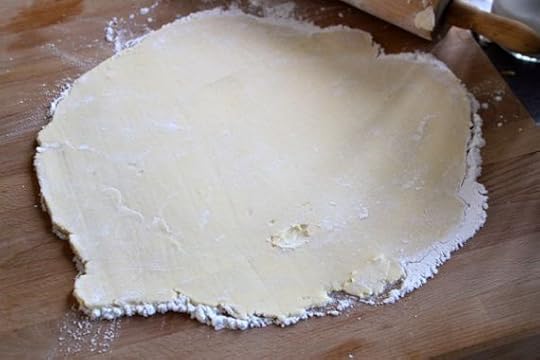
and transferred it over, not really minding if I had to patch it back together.

I knew I’d be covering it up with the the frangipane filling. However I put the rest of the crust in the refrigerator to get it to harden so that when I rolled that out, it would transfer smoothly.
Frangipane (pronounced frawn-gee-pahn) is a mixture of pastry cream and almond cream. It sounds complicated, but it’s not. We’re going to make both.
Okay, so for the pastry cream, take a cup of whole milk and heat it up with 1/4 teaspoon vanilla bean powder. I was able to buy the powder so I didn’t have to cut the bean. But you can substitute a teaspoon of vanilla if you don’t have it.

Whisk 3 egg yolks, 2 1/2 tablespoons of corn starch and a third cup of sugar.

When the milk is hot, pour it in slowly while you whisk it all together.
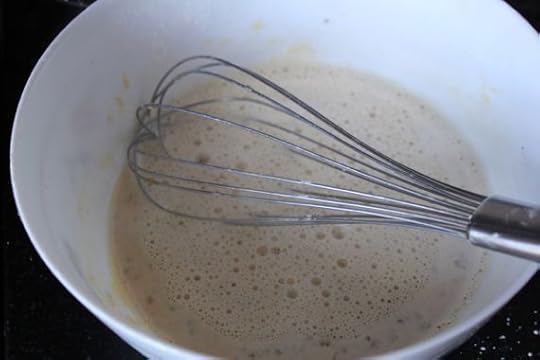
Put it back on the stove and whisk it continually until the mixture starts to thicken. It doesn’t take long.

When that’s ready, mix in 25 g butter (2T). Your pastry cream is done.
Pour that into the crust. I feel like I should excuse the tiny lumps you see in the cream. I didn’t stir continuously as I was supposed to while it was heating up because I was looking for my almond powder and realising I didn’t have enough. Don’t make that mistake. Stir constantly while it’s cooking.

Now for the almond cream. I got my recipe for that here.
You need a rounded cup and a half of ground almonds, but I only had a cup so I used that and it seemed to work. Add in a half cup sugar, 2 eggs, and 75 g softened butter (6T). Mix it all together.

Then pour that on the pastry cream.

It doesn’t really look all that different from the pastry cream actually.
Now, this is where you put the fève. I forgot to put it in. I’ll get to that in a minute. Otherwise, roll out the rest of the dough, fold it over, and use two spatulas to carry it over and place it on top of the filling.
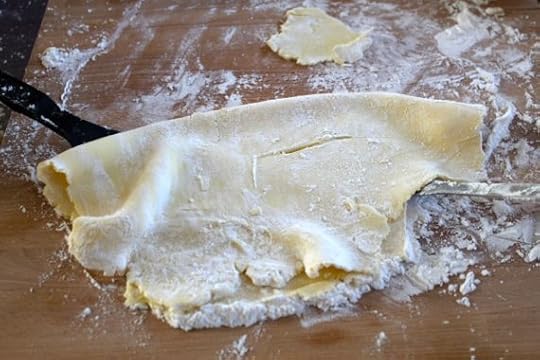
Squeeze the crust together so the filling stays inside.

Then you can take a sharp knife and make a little design on top. Even a criss-cross will do. This helps me to hide the wrinkles, which are not supposed to be on top (but don’t worry – they will also even out in the cooking).

Okay. Now about the fève. That actually means “bean” and they are little porcelain figurines you hide inside the cake. Here are two examples.

Normally you hide it before you put the top layer of crust, but since I forgot, I’m going to slip it in. Like so.
 Pat that little crust opening back together and brush on your egg yolk. (If you haven’t already). And see? You can’t tell at all that something was slipped in at the last minute.
Pat that little crust opening back together and brush on your egg yolk. (If you haven’t already). And see? You can’t tell at all that something was slipped in at the last minute.
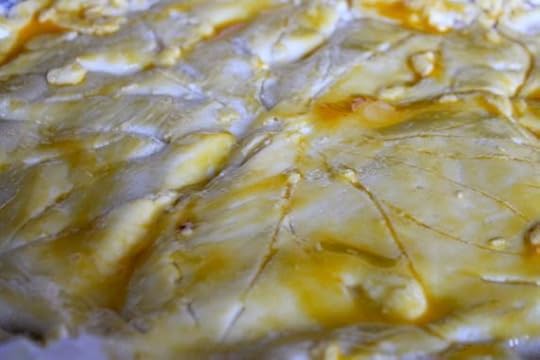 Into the oven it goes for a half-hour.
Into the oven it goes for a half-hour.
Now that is one beautiful King’s Cake, if I do say so myself.

I don’t know how prevalent this Catholic tradition is outside of Europe (and whether or not you’re familiar with it), but the person who gets the fève is king for the day. The galette des rois in France are sold with little paper crowns for that purpose.

And here is our perfect gluten-free almond paste King’s Cake. It’s too filling to eat as a dessert, so it should be served for afternoon tea (or coffee). It’s traditionally served in France with cider – a sparkling alcoholic apple cider from Normandy/Brittany. We don’t drink alcohol, so we stick with tea.
The French will eat it every Sunday afternoon in January, and you don’t even have to be Catholic to enjoy it!
 How about you? Would you like to be king for the day?
How about you? Would you like to be king for the day?
5.0 from 1 reviews
Galette des Rois à la Frangipane (gluten-free)
A cake to be eaten on the Epiphany.
From: Lady Jennie
Recipe type: Dessert
Cuisine: French
Serves: 8
Ingredients
Crust:
2 cups (gluten-free) flour mix
½ cup tapioca flour
½ cup confectioner sugar
1 teaspoon large grain sea salt
1 cup water
1 egg white (save the yolk)
Pastry Cream:
1 cup milk
¼ vanilla bean powder (or 1t vanilla extract)
3 egg yolks
2½ T corn starch
⅓ cup sugar
25 g butter (2 T)
Almond Cream:
140g almond powder (1.5 cups rounded)
100 g sugar – ½ cup
2 eggs
75 grams softened butter (6T)
a fève
Instructions
Preheat the oven to 175°C (200°C)
Make the dough by blending all the ingredients in the cuisinart.
Cover your pan with wax paper (or roll half the dough on the wax paper and transfer it over. Probably the smarter move).
Roll half the dough and place it in the pan. Refrigerate the rest.
For the pastry cream, heat the milk and vanilla.
Stir the corn starch, egg yolk and sugar.
Mix the hot milk in slowly, then transfer back to stove.
Heat the cream until it thickens, stir without cease.
Mix in the butter and it’s ready. Pour that on pie crust.
For the almond cream, mix all the ingredients together, and then pour that on top of the pastry cream.
Place the fève somewhere on the cake.
Roll out the remaining dough and cover the filling. Pinch the ends.
Cut a design into the top and brush with egg yolk.
Cook for a half hour, turning once if needed to avoid burning one side.
#version#
The post Galette des Rois à la Frangipane (gluten-free) appeared first on A Lady In France.



